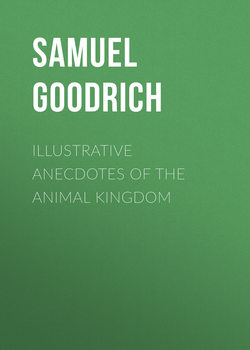Illustrative Anecdotes of the Animal Kingdom

Реклама. ООО «ЛитРес», ИНН: 7719571260.
Оглавление
Goodrich Samuel Griswold. Illustrative Anecdotes of the Animal Kingdom
GENERAL CLASSIFICATION OF THE ANIMAL KINGDOM
VERTEBRATA
CLASS MAMMALIA
ORDER I. BIMANA, TWO-HANDED. MAN
ORDER II. QUADRUMANA, FOUR-HANDED ANIMALS
APES
THE BABOON
MONKEYS
ORDER III. CARNARIA, BUTCHERING ANIMALS
BATS
HEDGEHOG
THE MOLE
THE BEAR
THE RACCOON
THE COATI
THE BADGER
THE GLUTTON
THE WEASEL
THE POLECAT
THE FERRET
THE MINK
THE MARTEN
THE SABLE
THE SKUNK
THE OTTER
THE DOG
THE WOLF
THE FOX
THE HYENA
THE LION
THE TIGER
THE PANTHER
THE LEOPARD
THE JAGUAR
THE AMERICAN PANTHER
THE CAT
ORDER IV. AMPHIBIA, AMPHIBIOUS ANIMALS
THE SEAL
THE WALRUS
ORDER V. MARSUPIALA, POUCHED ANIMALS
THE OPOSSUM
THE KANGAROO
ORDER VI. RODENTIA, GNAWING ANIMALS
THE SQUIRREL
THE MOUSE
THE DORMOUSE
THE RAT
THE BEAVER
THE PORCUPINE
THE HARE
ORDER VII. EDENTATA, ANIMALS WITHOUT FRONT TEETH
THE SLOTH
THE PLATYPUS
ORDER VIII. PACHYDERMATA, THICK-SKINNED ANIMALS. THE ELEPHANT
THE HIPPOPOTAMUS
THE RHINOCEROS
THE WILD BOAR
THE DOMESTIC HOG
THE TAPIR
THE HORSE
THE PONY
THE ASS
THE ZEBRA
ORDER IX. RUMINANTIA, RUMINATING ANIMALS – THOSE THAT CHEW THE CUD. THE CAMEL
DEER
THE GIRAFFE
THE GOAT
THE SHEEP
THE OX
THE BISON
ORDER X. CETACEA, THE WHALE KIND
THE DOLPHIN
THE GRAMPUS
THE PORPOISE
THE WHALE
CLASS II. AVES… BIRDS
ORDER I. ACCIPITRES, BIRDS OF PREY. VULTURES
HAWKS
THE EAGLE
THE OWL
ORDER II. PASSERINÆ
THE SHRIKE, OR BUTCHER-BIRD
THE KING-BIRD
THE CEDAR-BIRD
THE SCARLET TANAGER
THE MOCKING-BIRD
THE BALTIMORE ORIOLE
THE WREN
THE PURPLE MARTIN
THE SWALLOW
THE SKYLARK
THE TITMOUSE
THE CANARY-BIRD
THE BULFINCH
THE SPARROW
THE CROW
THE RAVEN
THE MAGPIE
THE HUMMING-BIRD
THE BLUE JAY
ORDER III. SCANSORIÆ, CLIMBING BIRDS. THE CUCKOO
THE WOODPECKER
THE PARROT
ORDER IV. GALLINACEA, RESEMBLING THE DOMESTIC HEN. THE COCK
THE PHEASANT
THE RUFFED GROUSE
THE PIGEON
ORDER V. STILTED OR LONG-LEGGED BIRDS
THE ADJUTANT, OR MARABOO CRANE
THE STORK
THE HERON
THE FLAMINGO
ORDER VI. PALMIPEDES, WEB-FOOTED BIRDS. THE GULL
THE CORMORANT
THE SWAN
THE GOOSE
CLASS III. REPTILIA … REPTILES
ORDER I. CHELONIA, TORTOISE
ORDER II. SAURIA, LIZARDS
THE CROCODILE
THE ALLIGATOR
THE SALAMANDER
ORDER III. OPHIDIA, SERPENTS
ORDER IV. BATRACHEA, THE FROG KIND. THE FROG
THE TOAD
CLASS IV. PISCES … FISHES
THE MACKEREL
THE SWORD-FISH
THE PIKE
THE GOLDEN CARP
THE SALMON
THE HERRING
THE SHARK
INVERTEBRATA
CLASS I. MOLLUSCA … SOFT ANIMALS. THE SQUID
THE NAUTILUS
THE SNAIL
THE OYSTER
THE SCALLOP
CLASS II. ARTICULATA … JOINTED ANIMALS
THE LEECH
THE CRAB
THE SPIDER
THE SCORPION
THE DEATH-WATCH
THE GLOWWORM
THE FIRE-FLY
THE BEETLE
THE EARWIG
THE CRICKET
THE LOCUST
THE ANT
THE CATERPILLAR
THE BUTTERFLY
THE MOTH
THE SILKWORM
FLIES
CLASS RADIATA … RADIATED ANIMALS
POLYPI
Отрывок из книги
The mammalia include not only man, the head of creation, but, generally, those animals which have the most numerous and perfect faculties, the most delicate perceptions, the most varied powers, and the highest degrees of intelligence. All the species have a double heart; red, warm blood; and a nervous system more fully developed than that of any other animals. This class is divided into nine orders, under each of which we shall notice some of the more remarkable species.
Of this race there is one species, yet divided into many nations, kingdoms, and tribes. These are all grouped under five races: 1. The Caucasian, or white race, including the most highly civilized nations; 2. The Mongolian, or yellow race, including the Tartars, Chinese, Japanese, &c.; 3. The Malay, or brown race, including the people of Malacca, and most of the Oceanic islands; 4. The American, or red race, including the American Indians; and 5. The African, or black race, including Negroes.
.....
"Some years ago," says Mr. Waterton, in his "Wanderings in South America," "I went to the River Paumaron, with a Scotch gentleman, by name Tarbet. We hung our hammocks in the thatched loft of a planter's house. Next morning, I heard this gentleman muttering in his hammock, and now and then letting fall an imprecation or two, just about the time he ought to have been saying his morning prayers. 'What is the matter, sir?' said I, softly; 'is any thing amiss?' 'What's the matter?' answered he, surlily; 'why, the vampyres have been sucking me to death.' As soon as there was light enough, I went to his hammock, and saw it much stained with blood. 'There,' said he, thrusting his foot out of the hammock, 'see how these infernal imps have been drawing my life's blood.' On examining his foot, I found the vampyre had tapped his great toe. There was a wound somewhat less than that made by a leech. The blood was still oozing from it. I conjectured he might have lost from ten to twelve ounces of blood. Whilst examining it, I think I put him into a worse humor, by remarking that a European surgeon would not have been so generous as to have blooded him without making a charge. He looked up in my face, but did not say a word. I saw he was of opinion that I had better have spared this piece of ill-timed levity."
This animal belongs exclusively to the eastern continent, and is well known from the thick and sharp prickles with which its back and sides are covered, and the contractile power by which it can draw its head and belly within the prickly covering of its back, so as to give it the appearance of a ball. It is found near hedges and thickets, from the fruits and herbage of which it obtains its food. It also feeds upon small animals, such as snails and beetles.
.....